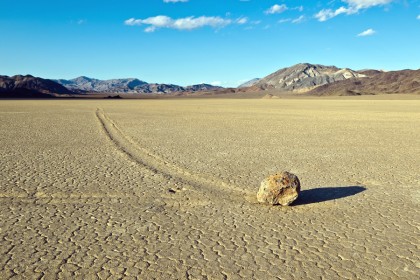The mystery of Death Valley's "sailing stones" has long stumped visitors to the national park and scientists alike. How do rocks at an area called Racetrack Playa, some larger than a microwave, move several yards across the desert floor, leaving tell-tale trails in the sand?

Image caption: The mystery of "sailing stones" in Death Valley National Park in California has puzzled scientists for decades.
Image credit: iStock Photo
Ralph Lorenz, a planetary scientist at the Johns Hopkins University Applied Physics Laboratory, may have cracked the case at his kitchen table. Smithsonian.com explains Lorenz's hypothesis and how it came about.
Lorenz employed a tried-and-true method for testing his nascent idea: the kitchen-table experiment. "I took a small rock, and put it in a piece of Tupperware, and filled it with water so there was an inch of water with a bit of the rock sticking out," he says. "I put it in the freezer, and that then gave me a slab of ice with a rock sticking out of it." He flipped the rock-ice hybrid upside down and floated it in a tray of water with sand on the bottom. By merely blowing gently on the ice, he realized, he could send the embedded rock gliding across the tray, scraping a trail in the sand as it moved. After decades of theoretical calculations by countless scientists, the answer seemed to be sitting on his tabletop.
Lorenz and his co-investigators detailed their findings in a 2011 article in the American Journal of Physics.
Read more from Smithsonian.comPosted in Science+Technology
Tagged applied physics laboratory, earth and planetary sciences, ralph lorenz








